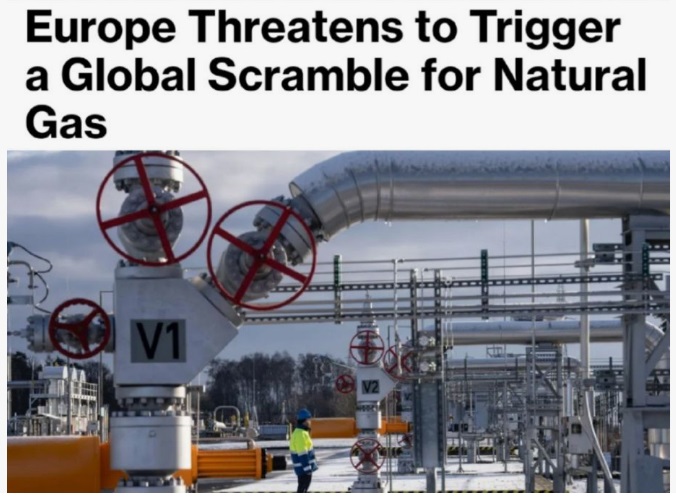
Loss of Russian pipeline supplies will stoke demand for LNG and could squeeze out poorer emerging nations, notes Bloomberg.
The world is bracing for a fight for natural gas supplies this year, prolonging the pain of higher bills for consumers and factories in energy-hungry Europe and putting poorer emerging countries from Asia to South America at risk of getting priced out of the market.
For the first time since the energy crisis was turbocharged by Russia’s war in Ukraine, Europe risks failing to meet its storage targets for next winter, setting the stage for one last scramble for supplies before new liquefied natural gas capacity starts to ease the situation next year.
While Europe has enough gas reserves to get through this winter and prices have eased since the start of the year, inventories are being eroded by cold weather, which swept across the continent this weekend. Supply options have been squeezed since the start of this year, when Russian pipeline deliveries through Ukraine ceased following end of a transport agreement.
“There will certainly be an energy gap in Europe this year,” said Francisco Blanch, commodity strategist at Bank of America Corp. “That means that all the incremental LNG that’s coming online this year around the world will go into making up for that shortfall in Russian gas.”
To cover its projected demand, Europe will need to import as much as an extra 10 million tons per year of LNG — about 10% more than in 2024, according to Saul Kavonic, an energy analyst at MST Marquee in Sydney. New export projects in North America could help ease market tightness, but that hinges on how quickly the facilities can ramp up production.
With fewer options to restock for next winter, Europe will need LNG shipments, pulling some away from Asia, home to the world’s biggest consumers. Depending on how demand shapes up, the competition would drive prices higher than countries like India, Bangladesh and Egypt can afford and weigh on Germany’s economic recovery.
Gas futures in Europe, which typically also impact Asian spot LNG prices, are still about 45% higher than at the same period last year and contracts are trading at around triple pre-crisis levels so far in 2025.
Price surges “would be made worse if Asia-Pacific inventories are depleted as well, which would lead to competition for cargoes,” said Jason Feer, global head of business intelligence at energy brokerage Poten & Partners Inc. in Houston.
It isn’t easy for all utilities and industries to find alternatives to gas. That’s a particular problem for Germany, which was reliant on Russia for more than half of its gas supplies before the Kremlin invaded Ukraine in 2022.
With its manufacturing sector laboring under higher costs, energy security has become a major issue in the country’s Feb. 23 snap election. The far-right Alternative for Germany is No. 2 in the polls in part because the party wants to revive cheap pipeline deliveries from Moscow to shore up manufacturing competitiveness.
Those losing out to Europe’s ability to pay a hefty premium for gas will be Asia’s developing nations, with some cargoes already diverting to take advantage of higher rates.
It’s a similar situation in South America. Brazil struggled to replace waning hydropower generation following a drought-stricken period, and Argentina could be drawn into the competition for LNG for its upcoming heating season.
Egypt is also exposed. The country surprised the market last year when it shifted from LNG exporter to importer as it grappled with summer blackouts, boosting purchases to the highest level since 2017, according to ship-tracking data compiled by Bloomberg. The country may still require dozens of shipments this year to survive summer heat.
For LNG sellers, already reaping benefits of higher prices, the squeeze creates opportunities. In some cases, LNG producers may be able to ramp up capacity similar to an export boost that happened in the crisis year of 2022, according to Ogan Kose, a managing director at consultancy Accenture.
The outlook depends largely on how quickly new production facilities start up. Last year, growth was negligible as Egypt stopped exports and Russia’s newest Arctic LNG 2 plant was stifled by US sanctions, according to Laura Page from energy data firm Kpler.
That puts the spotlight on the US. The world’s biggest LNG supplier has for years pitched to save Europe from gas starvation and the message is likely to get louder after Donald Trump enters office. He has already threatened tariffs if Europe doesn’t buy more American energy.
This year, US LNG exports are expected to rise by about 15%, according to Kpler, as Venture Global LNG Inc.’s Plaquemines and Cheniere Energy Inc.’s Corpus Christi expansion increase production. But the pace is in doubt. Cheniere has already warned the ramp-up this year will be “relatively slow.”
In Russia, still Europe’s second-biggest source of LNG, the focus will be on whether the nation will be able to maintain its exports after the US imposed sanctions on two smaller facilities. Western sanctions have already stifled the major Arctic LNG 2 project and affected key equipment and service supplies, delaying its full completion by two to three years, according to Claudio Steuer, energy consultant and faculty member of IHRDC in Boston.
read more in our Telegram-channel https://t.me/The_International_Affairs

 10:36 19.01.2025 •
10:36 19.01.2025 •






















